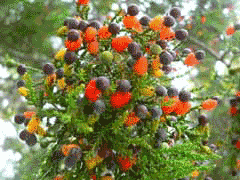 |
|
|
 |
| http://www.flickr.com/photos/sondyaustin/Dacrydium cupressinum |
Translate this page:
Summary
Physical Characteristics

 Podocarpus is an evergreen Tree growing to 6 m (19ft 8in) at a slow rate.
Podocarpus is an evergreen Tree growing to 6 m (19ft 8in) at a slow rate.
See above for USDA hardiness. It is hardy to UK zone 9. It is in leaf all year. The species is dioecious (individual flowers are either male or female, but only one sex is to be found on any one plant so both male and female plants must be grown if seed is required). and is pollinated by Wind. The plant is not self-fertile.
Suitable for: light (sandy), medium (loamy) and heavy (clay) soils. Suitable pH: mildly acid, neutral and basic (mildly alkaline) soils. It can grow in semi-shade (light woodland). It prefers moist soil.
UK Hardiness Map
US Hardiness Map
Synonyms
Podocarpus dacrydioides.
Plant Habitats
Edible Uses
Fruit - raw. A sweet taste[128, 153], it is palatable but with a slightly oily taste[173]. Also used as a masticatory[183] (this last report probably refers to the use of the resin). A resin is obtained from the tree[153], it is used as a chewing gum[173].
References More on Edible Uses
Medicinal Uses
Plants For A Future can not take any responsibility for any adverse effects from the use of plants. Always seek advice from a professional before using a plant medicinally.
None known
References More on Medicinal Uses
The Bookshop: Edible Plant Books
Our Latest books on Perennial Plants For Food Forests and Permaculture Gardens in paperback or digital formats.

Edible Tropical Plants
Food Forest Plants for Hotter Conditions: 250+ Plants For Tropical Food Forests & Permaculture Gardens.
More

Edible Temperate Plants
Plants for Your Food Forest: 500 Plants for Temperate Food Forests & Permaculture Gardens.
More

More Books
PFAF have eight books available in paperback and digital formats. Browse the shop for more information.
Shop Now
Other Uses
Plants are fairly amenable to trimming and could possible be grown as a hedge in mild areas of the country[200]. Wood - yellowish, easily worked. Used for general carpentry and for paper pulp[1, 46, 64, 171].
Special Uses
References More on Other Uses
Cultivation details
Requires sheltered moist woodland conditions[166]. Plants are not very frost-tolerant and are only hardy outdoors in the mildest areas of Britain[1, 81]. In their native habitat trees can reach 45 metres in height, but they are slow growing in Britain and rarely exceed 6 metres[11, 185].
References Carbon Farming Information and Carbon Sequestration Information
Temperature Converter
Type a value in the Celsius field to convert the value to Fahrenheit:
Fahrenheit:
The PFAF Bookshop
Plants For A Future have a number of books available in paperback and digital form. Book titles include Edible Plants, Edible Perennials, Edible Trees,Edible Shrubs, Woodland Gardening, and Temperate Food Forest Plants. Our new book is Food Forest Plants For Hotter Conditions (Tropical and Sub-Tropical).
Shop Now
Plant Propagation
The seed can be very slow to germinate, often taking 18 months or more. It is best sown in a cold frame as soon as it is ripe. Sow stored seed as early in the year as possible[200]. When they are large enough to handle, prick the seedlings out into individual pots and grow them on in the greenhouse for at least their first winter. Plant them out into their permanent positions in late spring or early summer, after the last expected frosts. Give them some protection from the cold for their first winter or two outdoors. Cuttings of short leading shoots, late summer in a frame[1]. Plant out in late spring after the last expected frosts. It side shoots are used as cuttings they will form prostrate plants[200].
Other Names
If available other names are mentioned here
Native Plant Search
Search over 900 plants ideal for food forests and permaculture gardens. Filter to search native plants to your area. The plants selected are the plants in our book 'Plants For Your Food Forest: 500 Plants for Temperate Food Forests and Permaculture Gardens, as well as plants chosen for our forthcoming related books for Tropical/Hot Wet Climates and Mediterranean/Hot Dry Climates. Native Plant Search
Found In
Countries where the plant has been found are listed here if the information is available
Weed Potential
Right plant wrong place. We are currently updating this section.
Please note that a plant may be invasive in one area but may not in your area so it’s worth checking.
Conservation Status
IUCN Red List of Threatened Plants Status :

Growth: S = slow M = medium F = fast. Soil: L = light (sandy) M = medium H = heavy (clay). pH: A = acid N = neutral B = basic (alkaline). Shade: F = full shade S = semi-shade N = no shade. Moisture: D = dry M = Moist We = wet Wa = water.

Expert comment
Author
(A.Rich.)de Laub.
Botanical References
44200
Links / References
For a list of references used on this page please go here
Readers comment
| Add a comment |
|
If you have important information about this plant that may help other users please add a comment or link below. Only comments or links that are felt to be directly relevant to a plant will be included. If you think a comment/link or information contained on this page is inaccurate or misleading we would welcome your feedback at [email protected]. If you have questions about a plant please use the Forum on this website as we do not have the resources to answer questions ourselves.
* Please note: the comments by website users are not necessarily those held by PFAF and may give misleading or inaccurate information.
To leave a comment please Register or login here All comments need to be approved so will not appear immediately.
|
|